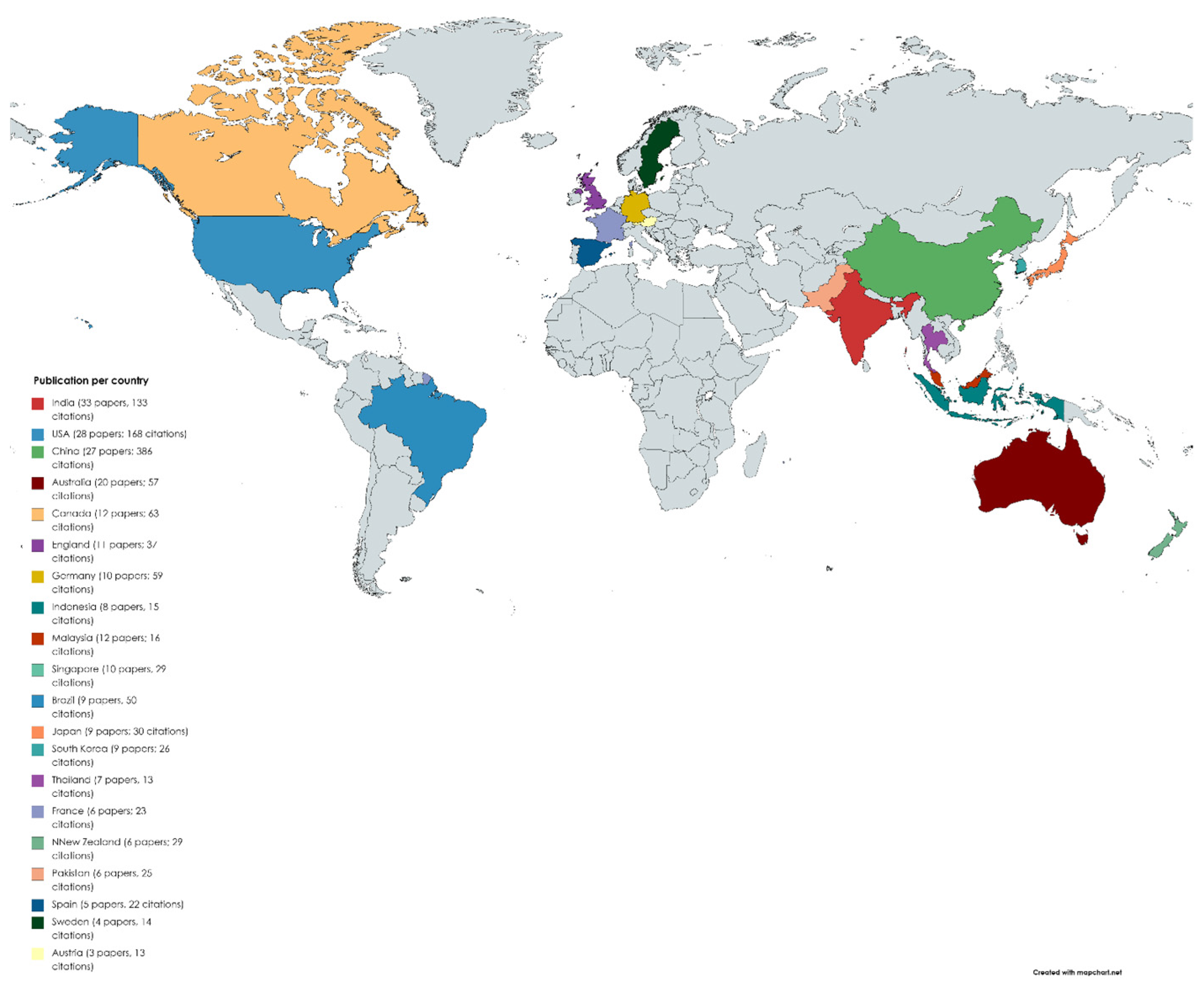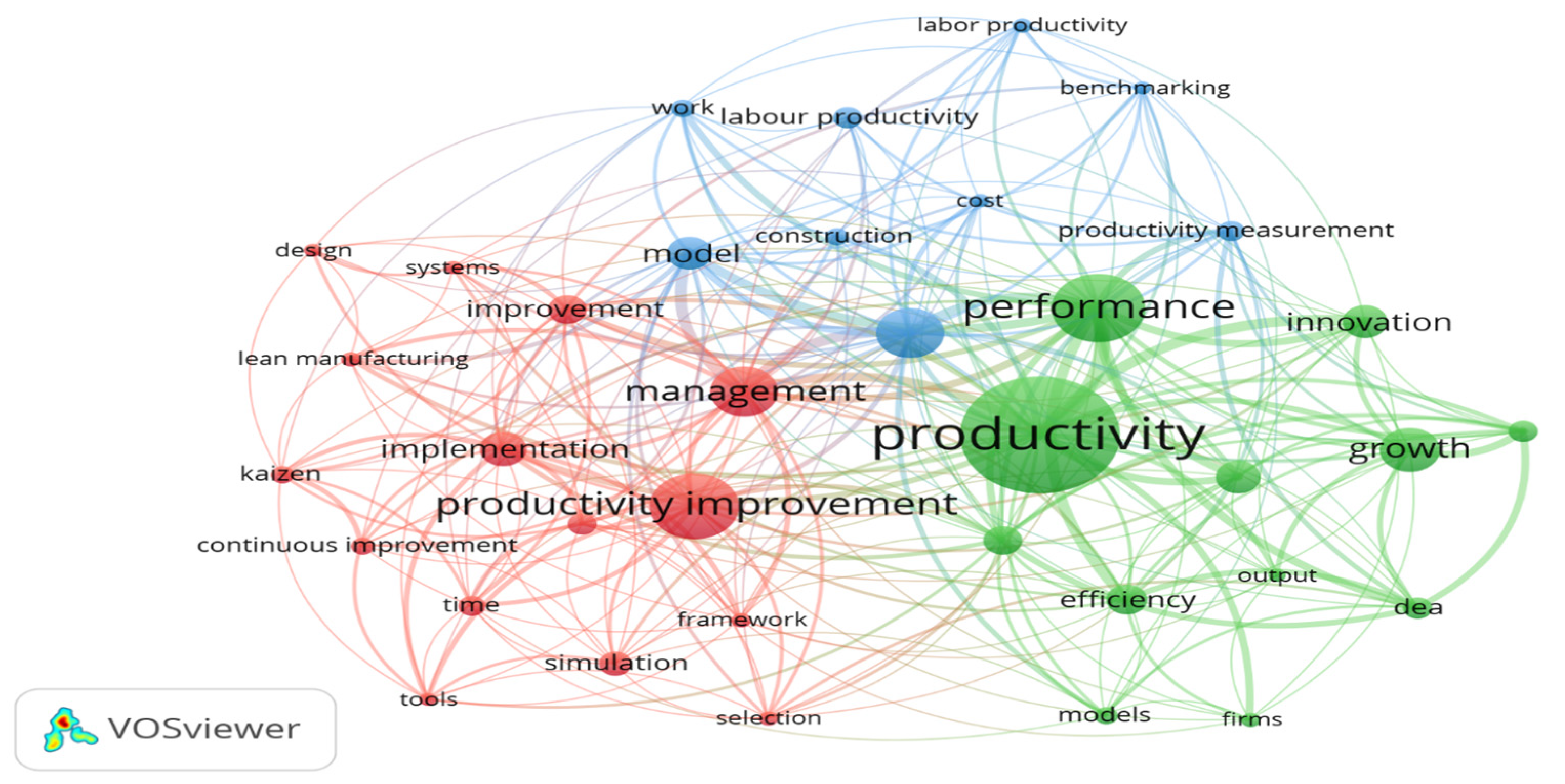A Bibliometric Analysis and Systematic Review of Productivity Management-Related Studies †
Abstract
1. Introduction
2. Literature Review
3. Methodology
4. Results and Discussion
4.1. Publications per Year
4.2. Publications per Country
4.3. Publications per Document Source
4.4. Most-Cited Publications
4.5. Publication per Author and Co-Authorship Network
4.6. Research Focus Based on Co-Occurring Keywords
4.7. Research Focus Based on Years of Publication
5. Conclusions
Author Contributions
Funding
Institutional Review Board Statement
Informed Consent Statement
Data Availability Statement
Conflicts of Interest
References
- Soto Lopez, D.; Garshasbi, M.; Kabir, G.; Bari, A.M.; Ali, S.M. Evaluating interaction between internal hospital supply chain performance indicators: A rough-DEMATEL-based approach. Int. J. Product. Perform. Manag. 2022, 71, 2087–2113. [Google Scholar] [CrossRef]
- Minh, N. Toyota’s production efficiency improvement management: Best practice for productivity evaluation and operation improvement. J. Adv. Manag. Res. 2023, 20, 385–408. [Google Scholar] [CrossRef]
- Stainer, A. Productivity management: The Japanese experience. Manag. Decis. 1995, 33, 4–12. [Google Scholar] [CrossRef]
- Hussain, A.; Ahmad, Q.W.; Haq, I.U.; Nazir, A.; Imran, S.; Islam, B.U. Improving Productivity and Quality in SMEs of Pakistan: A case study. Tech. J. 2015, 20, 103–114. [Google Scholar]
- Yemane, A.; Gebremicheal, G.; Meraha, T.; Hailemicheal, M. Productivity improvement through line balancing using simulation modelling (case study Almeda garment factory). J. Opt. Ind. Eng. 2020, 13, 153–165. [Google Scholar]
- Klingner, S.; Pravemann, S.; Becker, M. Service productivity in different industries—An empirical investigation. Benchmarking Int. J. 2015, 22, 238–253. [Google Scholar] [CrossRef]
- Huang, C.T.; Vinh, N.P.; Chen, Y.T.; Liang, T.T.; Nan, F.H.; Liu, P.C. Improving productivity management of commercial abalone Haliotis diversicolor supertexta and Haliotis discus hannai aquaculture in Taiwan: A bioeconomic analysis. Aquaculture 2019, 512, 734323. [Google Scholar] [CrossRef]
- Khan, J.H. Impact of total quality management on productivity. TQM Mag. 2003, 15, 374–380. [Google Scholar] [CrossRef]
- Nguyen, H.K.; Phan, A.C. Determinants for labour productivity improvement in hotel service: Empirical evidence from Vietnam. Int. J. Product. Qual. Manag. 2024, 41, 1–31. [Google Scholar] [CrossRef]
- De Oliveira, A.L.G.; da Rocha Junior, W.R. Productivity Improvement through the Implementation of Lean Manufacturing in a Medium-Sized Furniture Industry: A Case Study. S. Afr. J. Ind. Eng. 2019, 30, 172–188. [Google Scholar] [CrossRef]
- Brocke, J.V.; Simons, A.; Niehaves, B.; Niehaves, B.; Reimer, K.; Plattfaut, R.; Cleven, A. Reconstructing the giant: On the importance of rigour in documenting the literature search process. In Information Systems in a Globalising World: Challenges, Ethics and Practices; Newell, S., Whitley, E., Pouloudi, N., Wareham, J., Mathiassen, L., Eds.; Università di Verona, Facoltà di Economia, Departimento de Economia Aziendale: Verona, Italy, 2009; pp. 2206–2217. [Google Scholar]
- Baker, M.J. Writing a literature review. Market. Rev. 2000, 1, 219–247. [Google Scholar] [CrossRef]
- Fernandez, K.V. Critically reviewing the literature: A tutorial for new researchers. Australas. Market. J. (AMJ) 2019, 27, 187–196. [Google Scholar] [CrossRef]
- Torraco, R.J. Writing integrative literature reviews: Guidelines and examples. Hum. Resour. Dev. Rev. 2005, 4, 356–367. [Google Scholar] [CrossRef]
- Robinson, P.; Lowe, J. Literature reviews vs systematic reviews. Aust. N. Z. J. Public Health 2015, 39, 103. [Google Scholar] [CrossRef]
- Gil, M.; Wróbel, K.; Montewka, J.; Goerlandt, F. A bibliometric analysis and systematic review of shipboard Decision Support Systems for accident prevention. Saf. Sci. 2020, 128, 104717. [Google Scholar] [CrossRef]
- Aghimien, D.O.; Aigbavboa, C.O.; Oke, A.E.; Thwala, W.D. Mapping out research focus for robotics and automation research in construction-related studies: A bibliometric approach. J. Eng. Des. Technol. 2019, 18, 1063–1079. [Google Scholar] [CrossRef]
- Van Eck, N.J.; Waltman, L. Visualizing bibliometric networks. In Measuring Scholarly Impact: Methods and Practice; Ding, Y., Rousseau, R., Wolfram, D., Eds.; Springer: Cham, Switzerland, 2014; pp. 285–320. [Google Scholar]
- Wagstaff, C.; Kendrick, F.; Dennis, C.; Hollington, P.; Hess, T.; Brameld, J.; Mason, B. Productivity framework. Food Sci. Tech. (IFST Q. Mag.) 2018, 32, 52–57. [Google Scholar]
- Bamgbose, O.A.; Ogunbayo, B.F.; Aigbavboa, C.O. Barriers to Building Information Modelling Adoption in Small and Medium Enterprises: Nigerian Construction Industry Perspectives. Buildings 2024, 14, 538. [Google Scholar] [CrossRef]
- Yu, M. Processing trade, tariff reductions and firm productivity: Evidence from Chinese firms. Econ. J. 2015, 125, 943–988. [Google Scholar] [CrossRef]
- Du, J.; Chen, Y.; Huang, Y. A Modified Malmquist-Luenberger Productivity Index: Assessing Environmental Productivity Performance in China. Eur. J. Oper. Res. 2018, 269, 171–187. [Google Scholar] [CrossRef]
- Afsharian, M.; Ahn, H. Multi-period productivity measurement under centralized management with an empirical illustration of German saving banks. OR Spectr. 2017, 39, 881–911. [Google Scholar] [CrossRef]
- Nallusamy, S.; Saravanan, V. Optimization of process flow in an assembly line of manufacturing unit through lean tools execution. Int. J. Eng. Res. Afr. 2018, 38, 133–143. [Google Scholar] [CrossRef]
- Abolhassani, A.; James Harner, E.; Jaridi, M. Empirical analysis of productivity enhancement strategies in the North American automotive industry. Int. J. Prod. Econ. 2019, 208, 140–159. [Google Scholar] [CrossRef]
- Diewert, W.E.; Fox, K.J. Sunk costs and the measurement of commercial property depreciation. Can. J. Econ. 2016, 49, 1340–1366. [Google Scholar] [CrossRef]
- Mbachu, J.; Egbelakin, T.; Rasheed, E.O.; Shahzad, W.M. Influence of key role players on productivity outcomes in the residential building lifecycle. J. Eng. Des. Technol. 2017, 15, 528–551. [Google Scholar] [CrossRef]
- Rasheed, E.O.; Byrd, H. Can self-evaluation measure the effect of IEQ on productivity? A review of literature. Facilities 2017, 35, 601–621. [Google Scholar] [CrossRef]
- Schreyer, P.; Zinni, M.B. Productivity Measurement, R&D Assets, and Mark-Ups in OECD Countries. Rev. Income Wealth 2020, 67, 787–809. [Google Scholar]
- Purba, H.H.; Mukhlisin; Aisyah, S. Productivity improvement picking order by appropriate method, value stream mapping analysis, and storage design: A case study in automotive part center. Manag. Prod. Eng. Rev. 2018, 9, 71–81. [Google Scholar]
- Gopalakrishnan, M.; Skoogh, A. Machine criticality-based maintenance prioritization: Identifying productivity improvement potential. Int. J. Product. Perform. Manag. 2018, 67, 654–672. [Google Scholar] [CrossRef]
- Hwang, B.; Krishnankutty, P.; Zhu, L.; Caldas, C.H.; Shounak, A.; Mulva, S. Improving labour productivity in process construction maintenance and shutdown/turnaround projects. Int. J. Constr. Manag. 2018, 20, 822–836. [Google Scholar] [CrossRef]
- Pacheco, D.; Pergher, I.; Vaccaro, G.L.R.; Jung, C.F.; ten Caten, C. 18 comparative aspects between Lean and Six Sigma: Complementarity and implications. Int. J. Lean Six Sigma 2015, 6, 161–175. [Google Scholar] [CrossRef]
- Helleno, A.L.; Pimentel, C.A.; Ferro, R.; Santos, P.F.; Oliveira, M.C.; Simon, A.T. Integrating value stream mapping and discrete events simulation as decision making tools in operation management. Int. J. Adv. Manuf. Technol. 2015, 80, 1059–1066. [Google Scholar] [CrossRef]



| Source Title | Documents | Citations |
|---|---|---|
| International journal of productivity and performance management | 21 | 63 |
| International journal of production research | 13 | 71 |
| International journal of construction management | 6 | 5 |
| International journal of engineering research in Africa | 6 | 6 |
| International journal of lean six sigma | 6 | 31 |
| European journal of operational research | 4 | 64 |
| International journal of advanced manufacturing technology | 4 | 31 |
| International productivity monitor | 4 | 3 |
| Review of income and wealth | 4 | 15 |
| South African journal of economic and management sciences | 4 | 2 |
| Benchmarking—an international journal | 3 | 20 |
| Engineering journal—Thailand | 3 | 7 |
| Journal of engineering design and technology | 3 | 4 |
Disclaimer/Publisher’s Note: The statements, opinions and data contained in all publications are solely those of the individual author(s) and contributor(s) and not of MDPI and/or the editor(s). MDPI and/or the editor(s) disclaim responsibility for any injury to people or property resulting from any ideas, methods, instructions or products referred to in the content. |
© 2024 by the authors. Licensee MDPI, Basel, Switzerland. This article is an open access article distributed under the terms and conditions of the Creative Commons Attribution (CC BY) license (https://creativecommons.org/licenses/by/4.0/).
Share and Cite
Mueti, N.; Ogunbayo, B.F.; Aigbavboa, C. A Bibliometric Analysis and Systematic Review of Productivity Management-Related Studies. Eng. Proc. 2024, 76, 37. https://doi.org/10.3390/engproc2024076037
Mueti N, Ogunbayo BF, Aigbavboa C. A Bibliometric Analysis and Systematic Review of Productivity Management-Related Studies. Engineering Proceedings. 2024; 76(1):37. https://doi.org/10.3390/engproc2024076037
Chicago/Turabian StyleMueti, Ntwanano, Babatunde Fatai Ogunbayo, and Clinton Aigbavboa. 2024. "A Bibliometric Analysis and Systematic Review of Productivity Management-Related Studies" Engineering Proceedings 76, no. 1: 37. https://doi.org/10.3390/engproc2024076037
APA StyleMueti, N., Ogunbayo, B. F., & Aigbavboa, C. (2024). A Bibliometric Analysis and Systematic Review of Productivity Management-Related Studies. Engineering Proceedings, 76(1), 37. https://doi.org/10.3390/engproc2024076037







